The AHS Blog

A telescope by Henry Hindley
This post was written by Tim Hughes
The work of Henry Hindley of York was researched by Rodney Law and published in Antiquarian Horology (1971/2). The article describes two equatorially mounted telescopes signed Hindley.
The first of the two telescopes forms part of the collection of the Burton Constable Foundation, East Yorkshire, and the later instrument is now in the collection of the Science Museum London.
In recent months, the earlier instrument (circa 1740) has been through a process of conservation cleaning and close study by Tim Hughes of West Dean College.
The instrument is regarded as of significance and is known to have been purchased by William Constable for use in the eighteenth century observations of the Transit of Venus. The telescope mount bears much resemblance to that by James Short published in Philosophical Transactions in 1760, having meridional, equatorial and declination circles over a primary setting circle.
Interestingly, Hindley’s telescope mount is a combination of sound mechanical clockmaking practice – including the very precise and beautifully made worm gearing – and surprisingly unstable telescope mount which raises questions about the development process and Hindley’s involvement with the various stages of manufacture.
The instrument is signed on the micrometer box only, which is in itself a piece of clockmaking genius. Within the box are fitted four reticule frames, connected by intermeshing contrate wheels operated by a setting knob. The reticules form an adjustable square frame within the field of vision allowing angular measurement of the size or distance between objects.


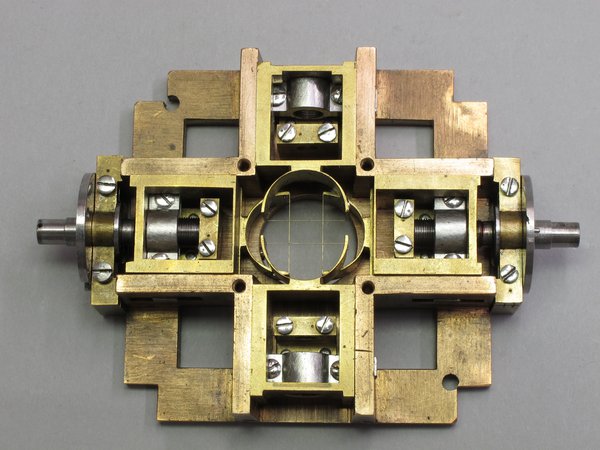

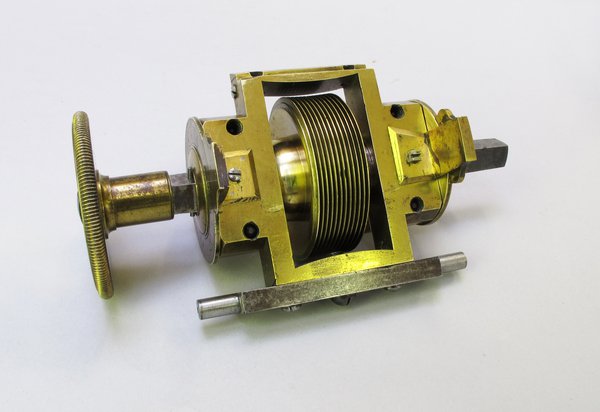
Work on cleaning and recording the instrument is almost completed and has been assisted by Charles Frodsham and Company Limited who have kindly carried out measurement of the gearing of the equatorial circle and its driving worm.
Once re-assembled, we intend to carry out field tests with the help of a professional surveyor in order to better understand the calibration and range of the instrument which may further inform its purpose and limitations. A paper giving a technical description of the construction of the instrument to appear in AH in due course!
Enicar will do
This post was written by James Nye
Collectors of Enicar watches may be intrigued by a story I recently uncovered.
The life of this popular Swiss brand (1913–1988) took in two world wars and the quartz revolution of late 1960s. The name Enicar derives simply from reversing the family name of the owners, Ariste and Emma Racine. Starting with movements from Schild, the couple expanded Enicar operations with a large manufactory in Lengnau (in Biel) after the Great War. The history of the firm is summarised here.

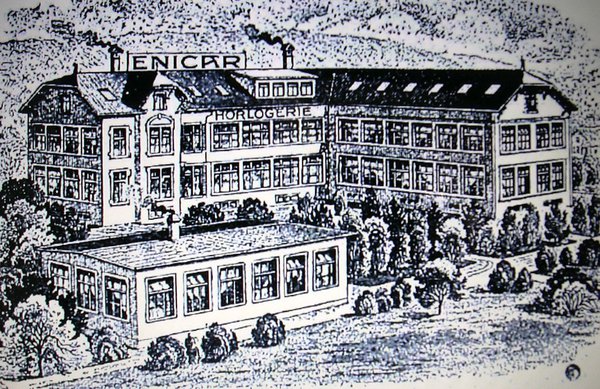
Ariste (junior) took over in 1938, and had to steer a cautious path through the Second World War. Some firms supplied both German and Allied clients, but we have some insight into Ariste’s sympathies through the extraordinary story of Major P. Oldfield, a wounded prisoner of war in Italy, who escaped to Switzerland, where he was in and out of hospital.
As part of his convalescence, he trained in simple clock assembly, developing an ambitious business plan with Ariste. After repatriation in 1944 to the UK, Oldfield helped his partner travel to London to seek permission for an alarm clock factory in the UK.

Racine had tried the scheme before, in 1939–1940, with the Clerkenwell firm of Robert Pringle & Co, but Edwin Pringle died in 1942, and in 1944 Racine used Oldfield as a new conduit to the Board of Trade to revive the idea, with a view to importing machinery from Switzerland, at first to assemble imported parts, but ultimately to manufacture alarms.
The British government was keen on schemes that could employ wounded ex-serviceman, and Oldfield was the walking advertisement. From alarms, Enicar UK would graduate to watch production.

The scheme did not progress, probably owing to resistance from the UK trade, perhaps hostile to competition from a Swiss national proposing to set up production without government subsidy. But the project interested the British government for some time in 1944–1945, and the file (BT 64/3661) at the National Archives would prove rewarding to the serious Enicar enthusiast. By all means contact me for help.
Horological horrors
This post was written by Peter de Clercq
Browsing the Digital Gallery of the New York Public Library I found a collection of cigarette cards, issued by tobacco manufacturers as an added incentive to buy their product.
On one of these cards we see a drawing of a longcase clock (the tall, standing type also known as grandfather clock) on a landing, with a riddle: ‘When is a clock on the stairs dangerous?’ The answer is printed on the back of the card: ‘When it runs down and strikes one’.


Jokes aside, longcase clocks can be dangerous, as one of the last Australian survivors of the Great War found out. When he died aged 106, the Daily Telegraph obituary had this lurid detail: two years earlier he had become trapped under his own grandfather clock when pulling up the weights. What an unexpected assailant for a veteran soldier! An AHS member sent me the clipping, after a neighbour of his had had the same misfortune. The lesson: make sure your longcase clock is firmly fixed to the wall.

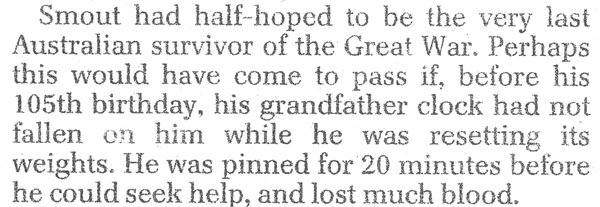
Of course, there may be situations where you simply don’t have time to do that.
In his latest monthly column ‘Diary of a clock repairer’ in Clocks Magazine, Robert Loomes writes how he delivered a restored grandfather clock to a house in the countryside. Just as he finished setting it up, a squirrel ran into his trouser leg (you couldn’t make it up). Quite understandably, he stumbled and fell, and the assembled clock was dashed to pieces.
In September 2010, an AHS member in the Canterbury region in New Zealand wrote to me: ‘It was a sad day for unsecured longcases last Saturday. There was a major earthquake in Christchurch and at least two friends who had yet to screw new acquisitions to the wall had them tossed across the room and smashed.’
At my request, he wrote a short piece about it for the journal, and supplied a photo of one of the damaged clocks. Sadly, five months later a second, more destructive earthquake hit Canterbury, causing massive destruction and killing 185 people. In that light, it would have been insensitive to print the piece about damaged clocks. Fortunately I could just withdraw it before the journal went to the printer.

Happy St Lubbock’s Day
This post was written by David Rooney
If you live in the UK or the Republic of Ireland, I hope you enjoyed the bank holiday earlier this week. Perhaps you went with family or friends to one of the many great museums with horology collections.
For bank holidays we can thank the remarkable Victorian polymath, John Lubbock (later Lord Avebury), who was the subject of a fascinating Royal Society conference I attended recently.
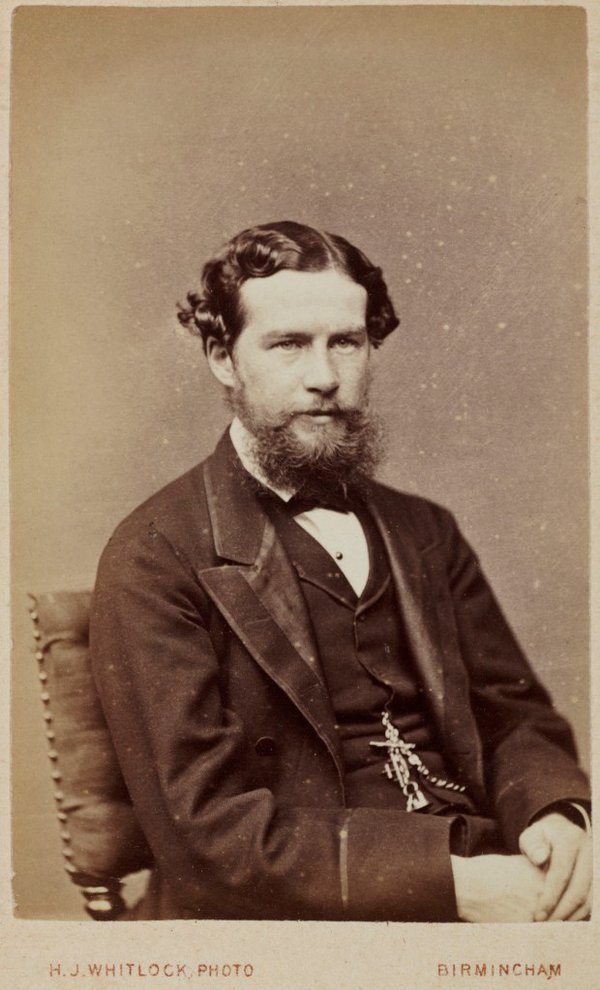
Lubbock is usually associated with the preservation of Britain’s ancient monuments such as Avebury. In 1882 his landmark Ancient Monuments Act was passed. But this was not nostalgia – Lubbock believed the relics of the past helped us understand our own progress, and he was about as modern as you could get in the late nineteenth century.
It was in electricity that Lubbock truly blazed a trail, a story I’ve recently been researching. Many in the AHS are interested in electrical timekeeping, a subject with more than a century and a half of history, and the place of the electrical industries in this story is crucial.
In 1882, the same year that he guided his ancient monuments bill to completion, Lubbock also sponsored the Electric Lighting Bill, and became a director of Thomas Edison’s offshoot company formed to bring electric lighting to Britain. His firm financed and founded the world’s first public electric power station, on Holborn Viaduct, and the following year he steered through the merger of Edison and Swan, Britain’s two pioneering electrical companies.
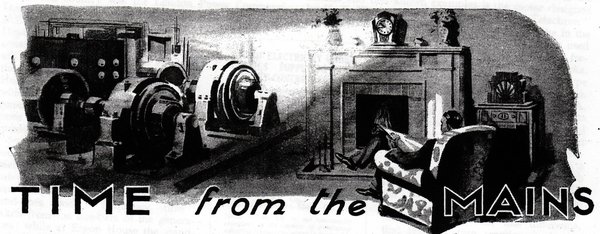
Lubbock once gave a lecture praising the work of William Cooke, Charles Wheatstone, Alexander Bain and Louis-Francois-Clement Breguet, amongst others. Electricians, yes, but horologists too.
So if, on your bank holiday museum trip, you saw clocks by any of the electrical pioneers, it is worth thinking of the role John Lubbock played in creating the modern electrical world – and in creating a world that values the relics of the past. And you can also thank him for giving you the day off.
Japanese time
This post was written by David Thompson
From the first appearance of the clock in Japan, when the Spanish Jesuit priest, St Francis Xavier, arrived with gifts for the Emperor, including at least one clock, in 1551, the story of mechanical timekeeping in that country has been an intriguing one, and one which lasted until the end of the Edo dynasty in 1873.
From 1612, when the Europeans were expelled from Japan and the country was closed to outside influences, the Japanese clockmakers were on their own for over 250 years. What they produced in terms of clocks was indeed ingenious.
First of all, how was time measured in Japan in that period? Take the hours of darkness and divide those up into six equal parts. Then take the hours of daylight and also divide those up into six equal parts and there you have it. Clearly if the day is divided in this way, the length of the daylight periods and those of darkness will vary throughout the year except at the equinoxes when all the hours will be equal and equivalent to two hours of European time.
Unfortunately, mechanical clocks like to keep equal unchanging hours as best they can. So, what did the Japanese clockmakers do in circumstances where they had no access to what was going on in far distant Europe at the time?
Three quite effective methods were devised to get round the problem:
- to have two separate oscillators in the form of weighted swinging bars known as foliots with adjustable weights to change the rate of the clock.
- to have moveable markers either on a round dial or on a flat bar, depending on the type of clock.
- to have a series of plates, usually fourteen, which would be changed periodically depending on the time of year.
In all three types the time indication would have to be adjusted twice per month.


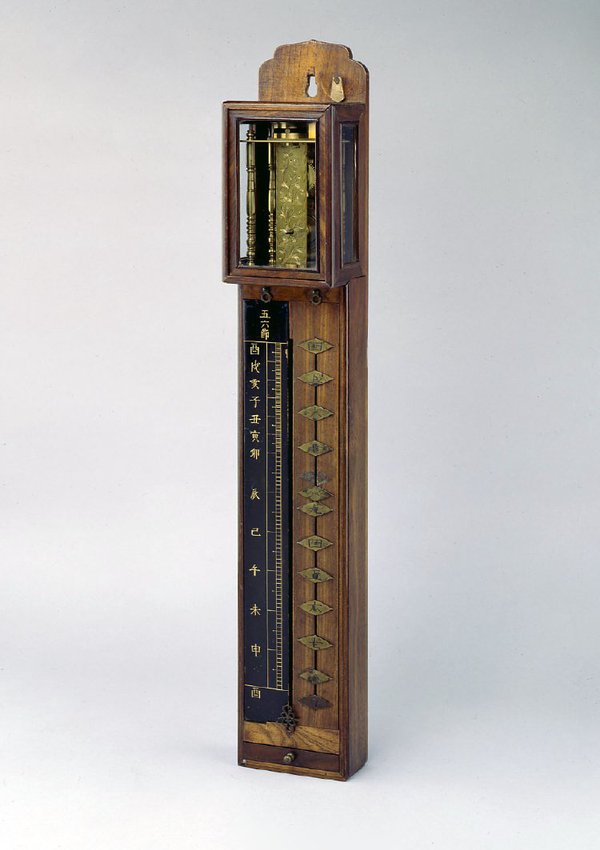

When it came to style, there were basically three types of clock in Japan:
- the stand or lantern clock, weight-driven and either mounted on the wall or placed on a stand.
- the table clock, designed to be placed on tables or on a suitable place in an alcove.
- the pillar clock, specifically made to hang on the thin wooden pillars which made up the framework of the inner paper wall of the house.
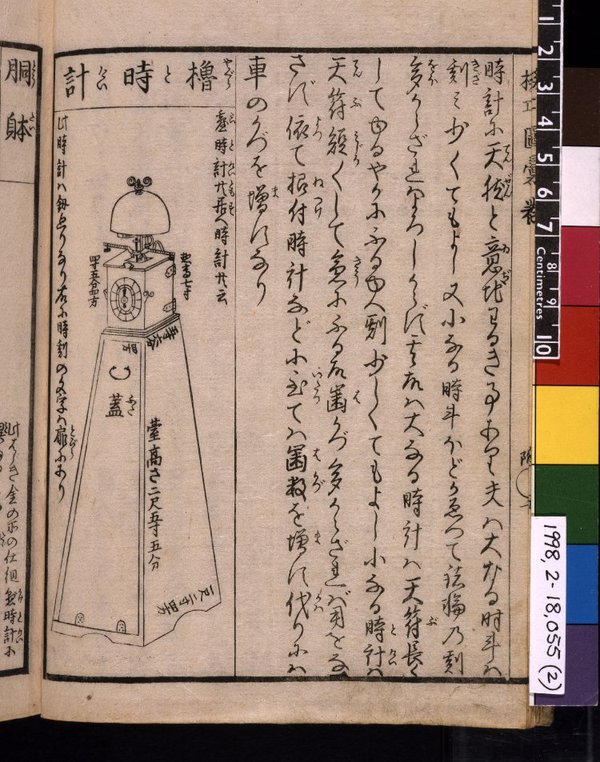

In the early period, the oscillating foliot was used as the timekeeping element, a single one in the earliest clocks and a double in the later, more sophisticated examples. As the technology progressed, pendulums or oscillating spring balance wheels were used – a larger form of the device found in mechanical watches.
Such clocks were only owned by the wealthy and were perhaps more used as status symbols than they were to tell the time and organise the household.
The basics – how a timekeeper works
This post was written by Oliver Cooke
Old clocks and watches are fascinating even without knowing how they work, but just a simple explanation provides a much deeper appreciation.
The timekeeping function of mechanical timekeepers can be explained as just five elements:
1 – Energy Source
All machines, including timekeepers, need energy to work. The energy is usually stored in a weight or spring. When it is wound, energy is transferred from our muscles and into the driving weight (as it moves up against the force of gravity) or the mainspring (as it tightens-up). This energy is released into the timekeeper as the weight drops or the mainspring unwinds.


2 – Wheels
An interconnected series of toothed wheels and pinions, known as a train, transmits the energy through the timekeeper. The energy source moves slowly and the wheel at the furthest end of the train moves quickly. This is the opposite of a car gearbox, where the engine revs quickly and the wheels on the road rotate more slowly.
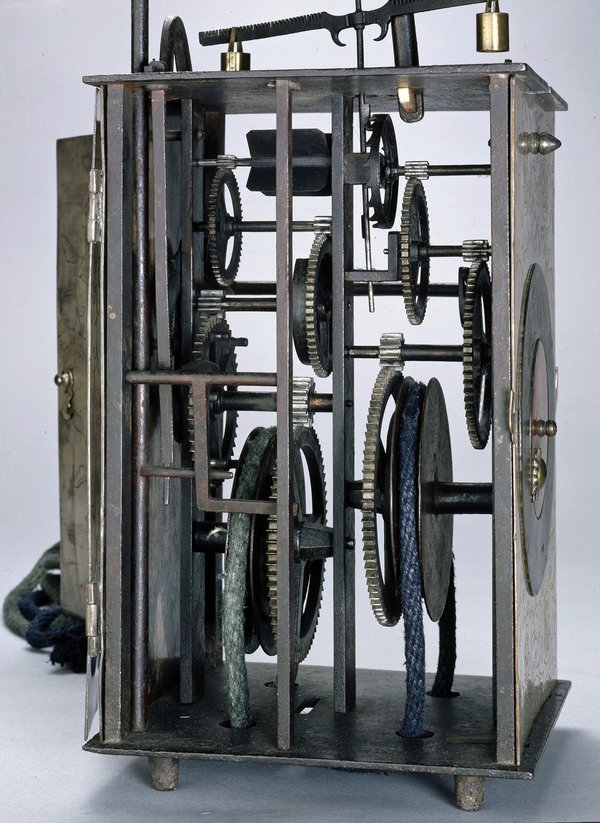
3 – Escapement
The escapement is connected to the quickly moving end of the train of wheels. Like a turnstile which allows one spectator through at a time, the escapement allows one wheel tooth to pass through (or 'escape') at a time. Without it, the wheels would whizz until the weight hit the floor. The ticking of a timekeeper is the sound of the escapement stopping a wheel tooth.
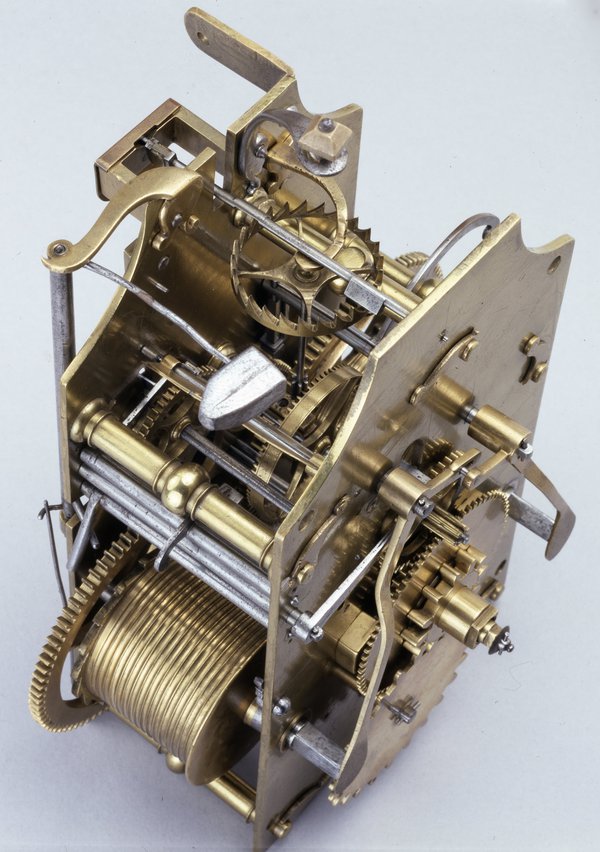

4 – Controller
The controller is connected to the escapement – it controls the rate at which it allows the teeth to pass through. As each tooth passes the escapement, it gives the controller a little push to keep it going. A common controller is a pendulum, which is just a hanging weight – give it a push and gravity makes it swing, at a steady rate. Because gravity is very constant, pendulums are great for good timekeeping.
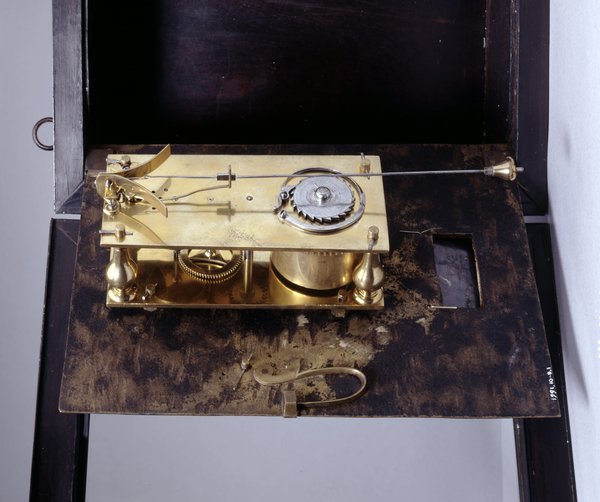
5 – Indicator
The part of the timepkeeper that tells us the time. Most familiar are hands on a dial. A clock striking a bell gives an aural indication of time – sometimes from many miles away.
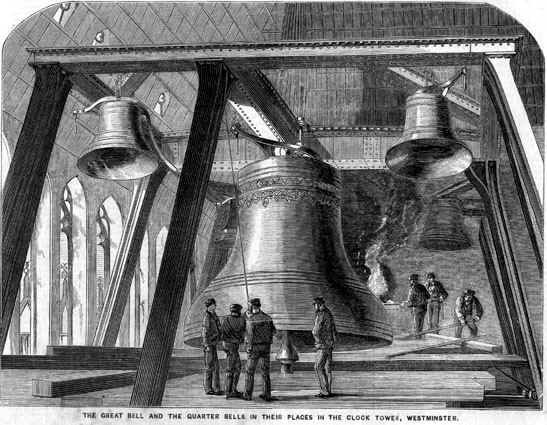
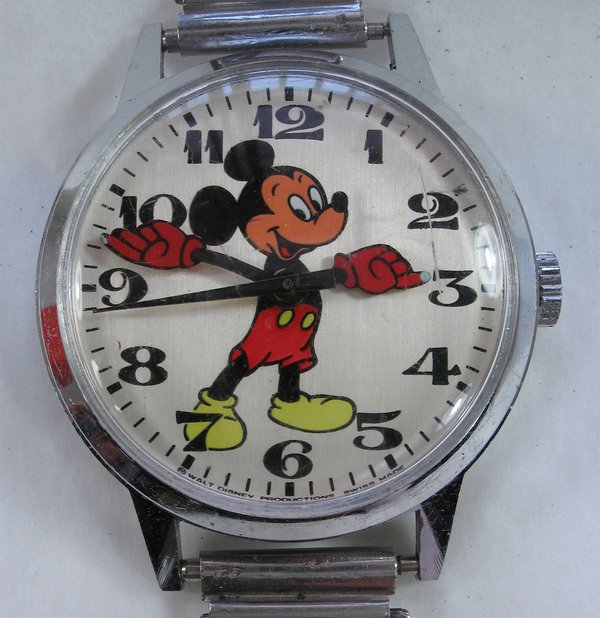
These five elements apply to (almost!) all mechanical timekeepers from the most ancient to the modern. They can vary wildly, but are there if you look!
PS This superb website has interactive animations showing how escapements (and some other horological bits) work.
King’s Cross – March 1952
This post was written by James Nye
I am spending every waking minute at present researching and writing about Smiths, owner of the English Clock Systems marque (ECS). Just now I came across an article about ECS in the March 1952 in-house Smiths magazine, and thought it worth sharing some of the accompanying images.
Based on surviving clocks, ECS is perhaps now best known for: a range of master and slave clocks, similar in concept to the Synchronome; synchronous public clocks; and process timers (e.g. darkroom clocks), which often turn up on eBay.
I don’t think any pictures of the inside of the original ECS works on Wharfdale Road, King’s Cross, have been published in a long time, so here we go, with a small selection.
The first shows Reg Boskett, showing off a modern clock dial for exterior use. In the next shot, Dolly Etheridge is shown operating a capstan lathe – Dolly joined the firm in 1942, and was also a competition dancer!
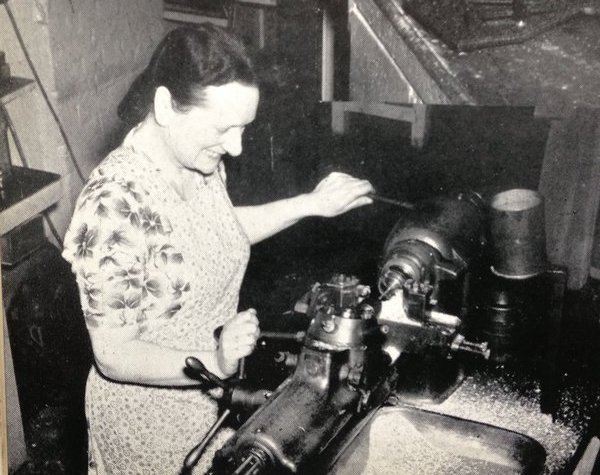
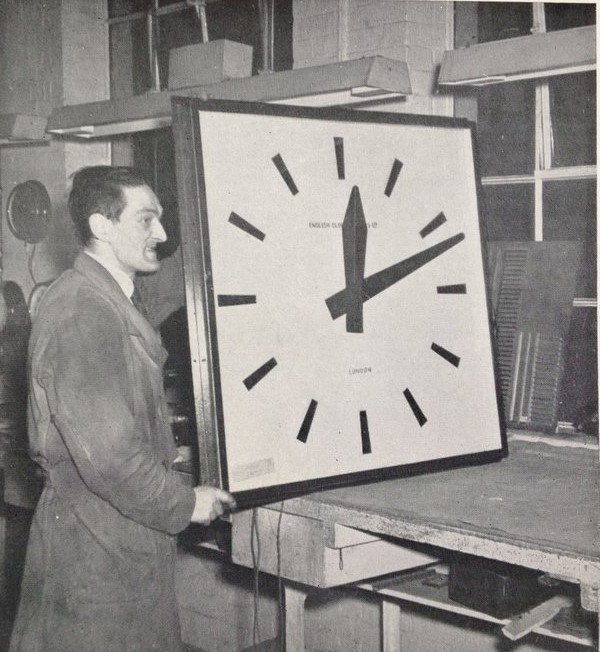
The firm’s original business focused on importing and installing Ericsson time recorders, but little is reported of the time recorders manufactured in fairly large numbers by ECS all the way through to the 1970s. Another shot shows Jimmy James, an old-timer from the firm’s beginnings, in the time recorder department, with an array of movements.
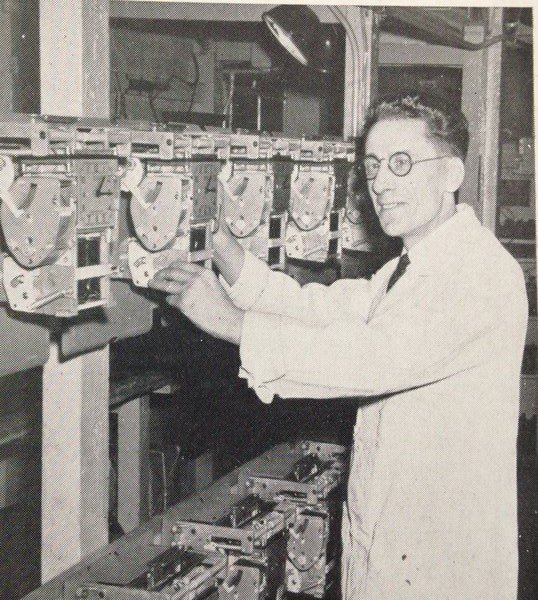
The final shot shows the most sought-after object, the ECS master clock, in the main assembly shop, with Jack Horsfall, foreman, using his Avometer to set-up the series resistance.
At the time all these pictures were taken, the firm still had a successful future ahead of it, but in less than thirty years its market was eroded, and it was absorbed by Blick in 1980.

Martin Ridout, webmaster for the AHS, is also our resident expert on the English Clock Systems (ECS) marque. The current state-of-the-art knowledge appears on his web-site and is distilled in two technical papers published by the society’s Electrical Group, Nos. 68 and 82.
Click here for details of the group and a full index of its papers. With luck, my continuing research will throw up some more flesh for Martin to add to the tale.
What became of the London sundial column?
This post was written by Peter de Clercq
My previous blog was about the sundial column at Seven Dials in central London. It is a reconstruction, erected in the 1980s to replace a column that had been there since 1694 but was taken down in 1773.
Popular legend has it that it had been ruined by a search for treasure presumed to be buried under it. Perhaps more truthful is that it was removed because the place had become a meeting-point for riff-raff. Whatever the reason, it was demolished and its remains landed in an architect’s garden in Addlestone, Surrey, southwest of London.
But fifty years later it was given a new lease of life in nearby Weybridge. The column was erected by public subscription in 1822 in memory of Frederica, the Duchess of York (1767-1820) who had been a popular local benefactress. It was decided that the dial stone was too heavy to cap it. A ducal coronet was used instead and the base inscribed to the Duchess. Two centuries later, the York Column at Weybridge still stands on what is named Monument Green.
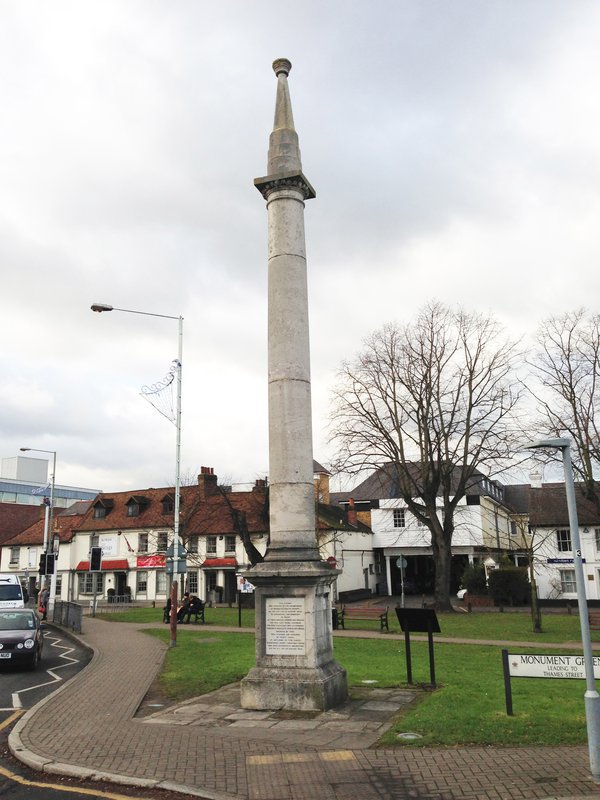


The original late 17th-century dial stone was used as a mounting block, to help the young or elderly or infirm to mount and dismount a horse or cart – not the best way to preserve a finely sculpted object. But this too has survived. More than three centuries old, and much the worse for wear, it lies to the west side of Weybridge Library. A plaque explains the historical significance of what to the average passer by must seem a very unassuming bit of stone.


My thanks go to AHS member Hugh Cockwill who lives nearby and took the photos at my request.
Time for everyone
This post was written by David Rooney
In 1947, the British chronicler of timekeeping, Donald de Carle, wrote the following tribute to American engineer Warren Marrison: ‘it is to him we are indebted for the most accurate timekeeper in the world.’
Marrison worked at the Bell Telephone Laboratories with J.W. Horton. And in 1927 they had made the first quartz clock. It was a game-changer.

The electric clock pioneer Frank Hope-Jones sought to calm fears about the new technology, explaining in 1944 that ‘There is no reason to be afraid of the quartz clock. The trick whereby the vibration of a resonator can be maintained by a vacuum tube – the triode valve of our radio set – is easily learnt.’
He was right. By the end of the Second World War, Britain’s national timekeeping service was based on quartz clocks and today the technology underpins most modern time measurement.
But I think the quartz clock was more than just a new technology. It was one of a series of twentieth-century innovations that represented a new scientific politics, presented publicly as an alternative to nationalism that was ripping the world apart at the time.
If you want to know more, and to contribute to the debate, you might be interested in ‘Time for Everyone’, an international symposium being held at the California Institute of Technology, Pasadena, CA, on 7 – 9 November this year. I’ll be there speaking about quartz clocks and the public politics of science, but if that’s not to your taste, you’ll also be able to hear other AHS speakers including Chris McKay, Jonathan Betts and James Nye, as well as a host of fabulous presenters from around the world.
The dog watch
This post was written by David Thompson
Anyone with connections with the sea and ships will tell you that the dog watch is a period of service between 4.00pm and 8.00pm and that it is split into two watches, the first and second watches on board ship.
Today there are any number of charms for bracelets and pendants in the form of dogs and I don’t doubt that there were all sorts for sale at the recent Crufts dog show. How many would guess, however, that you could buy a watch in the form of a silver dog in the 17th century.
A unique example exists in the British Museum collection where a silver-cased watch in the form of a dog can be found. The watch maker was Jacques Joly who lived in Geneva between 1622 and 1694. He made this watch in about 1660. It was during the middle period of the 1600s that there was a fashion in watches looking like real and animate objects, tulips, fritillary flowers, sea urchins and so on.
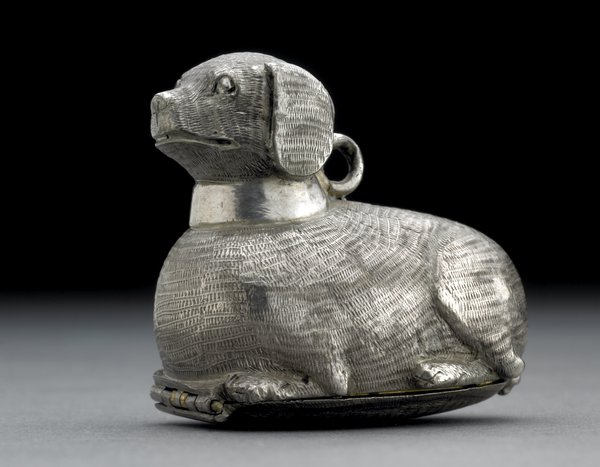


If the little dog needed a friend, there is a charming little lion living in the collections in the Ashmolean Museum in Oxford, this one with a movement made by Jean Baptiste Duboule. Of interest to both the dog and the lion is a little cast silver watch in the form of a hare which was stolen some years ago from the Musée de L’Horlogerie in Geneva. It has a movement inside signed, P. Duhamel, Geneva, and, as far as we know, a unique example of a watch case in that form.
Where can I see antiquarian horology?
This post was written by Oliver Cooke
I refer not to our society’s journal (which you can of course see by joining us!), but where can we see old clocks and watches?
I clearly remember dearly wanting to know this information when I first became properly interested in horology. Now I am in the loop and am l pleased to be able to share some good tips.
There are the major collections in national museums; the British Museum, the Royal Observatory Greenwich and the Science Museum. But since these are well-known, let their plugging end there for now and let instead us look at a couple of less well known collections from different ends of the country.
Starting down South, there is the finest private collection outside the institutions mentioned above – the Harris collection, in Belmont House in Kent. The collection is wide ranging with examples from all the major clock making countries and periods, but there is a strong focus on England’s horological ‘Golden Age’. Not only does the house have its collection, but it is a beautiful place to visit in its own right – it is a magnificent neo-classical house set in beautiful gardens in the North Downs.
So, if you have a partner who likes horology a little less than you, they will not be disappointed when joining you on a visit there. Jonathan Betts, sometimes author on this very blog, conducts a clock tour at 1.30 pm on the last Saturday every month during the season. Prior reservation is necessary – please see the Belmont House website for details.


Now, heading up North, another great place to visit is Fairfax House in York. Fairfax Houses houses the collection of Noel Terry (grandson of the founder of the confectionery firm), one of the finest private collections of the twentieth century.
Again, this House has much more to offer than just clocks and watches and of course it is bang in the middle of York, a city worth a visit in its own right. The house is open every day except Mondays for most of the year – do check their website.
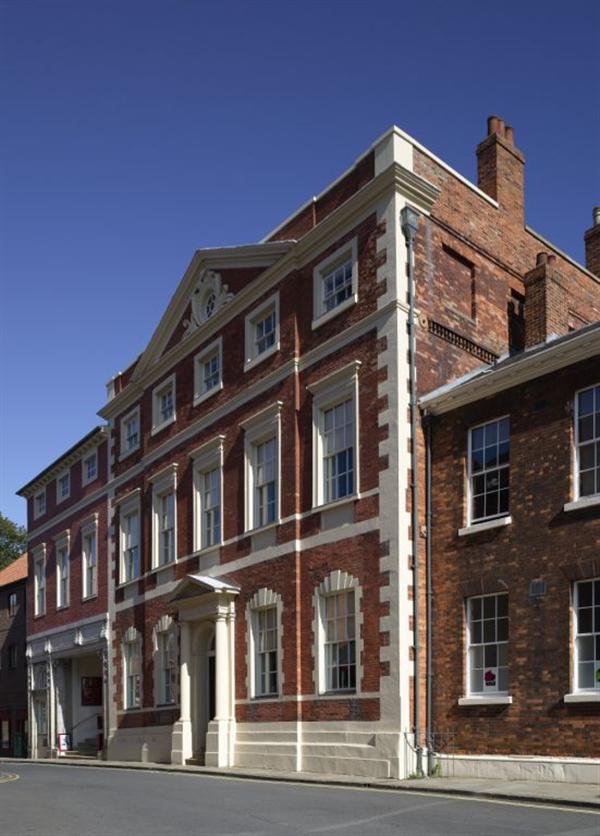
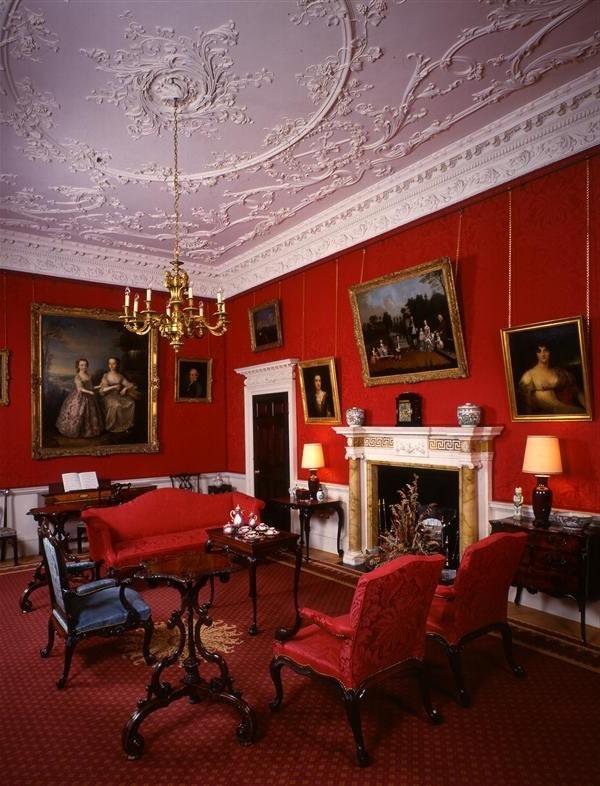
There are more collections to tell of, which can follow in a later post. Keep reading!
Venner chance comes along, take it
This post was written by James Nye
In November, David Rooney mentioned the Venner time switches in telephone kiosks. This prompted wheels to whir in my brain and I went hunting in my ‘reserve collection’ for something I acquired many years ago, by chance.

Unfortunately, the history of the firm as presently researched is somewhat sketchy. If anyone is interested in doing so, here is a workshop ledger from Venner, c.1934 onwards. It is a systematically arranged in-house descriptive and photographic catalogue of several hundred ‘specials’, produced from the early 1930s to the late 1940s. Every item had a unique code, all indexed, and most items have a fine quality photograph, with a scale included – these people meant business, and they were perfectionists.
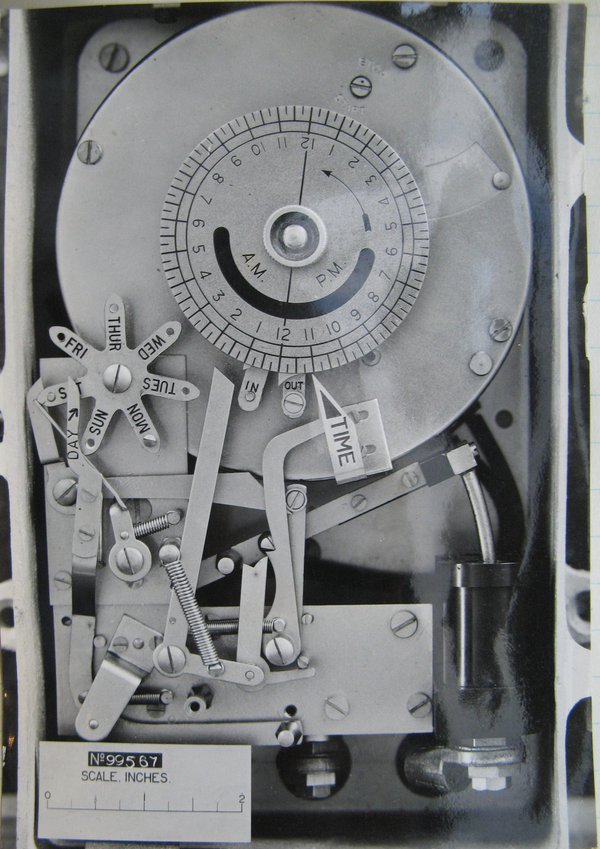
Venner master clocks are finely finished, but this meticulous approach extended to machinery that would probably be invisible throughout its life. As often in the mid-twentieth century, when electro-mechanics were relied on and before integrated circuits, the requirements for accurate timing and switching, perhaps with some programming, necessitated significant mechanical and engineering ingenuity. It is telling that each description starts with ‘special’.
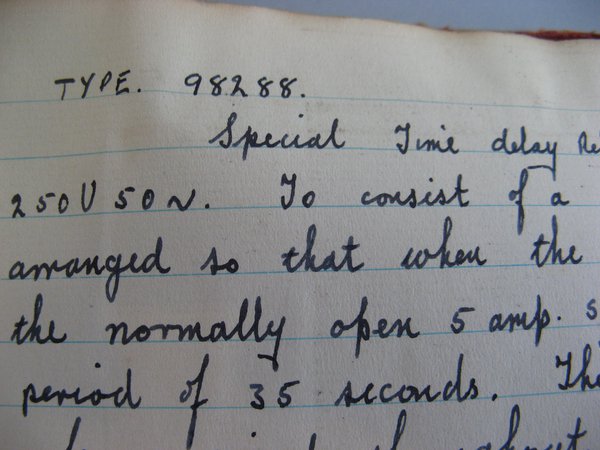
From 1938, we learn that the Royal Physical Society needed a system for lecturers, which would switch a green lamp to amber, one minute before time, and then to red when their allotted slot expired.

In all it is a marvellous piece of ephemera and testament to the very high standards set by manufacturers of mysterious clockwork black boxes which are worthy of closer study.

The sundial column at Seven Dials
This post was written by Peter de Clercq
As I live in central London, I often pass through Seven Dials, an area between the districts of Covent Garden and Soho where seven streets meet at a roundabout. In its centre stands a pillar or column with six vertical sundials at its top.

The area resulted from a building scheme of the politician-entrepeneur Thomas Neale MP (1641–1699), whose name lives on in nearby Neal’s Street and Neal’s Yard. He commissioned the architect and stonemason Edward Pierce to design and construct a sundial pillar in 1693-94 as the centrepiece of his development. Pierce’s drawing is in the British Museum and shows six sundial faces.
Why six, not seven? We are told that the column itself was the seventh, so it would act as style or gnomon, casting its shadow on the ground. If so, there must have been a noon mark somewhere. One thing is certain: the column never ‘supported a clock with six dials’, as the London Encyclopaedia tells us.
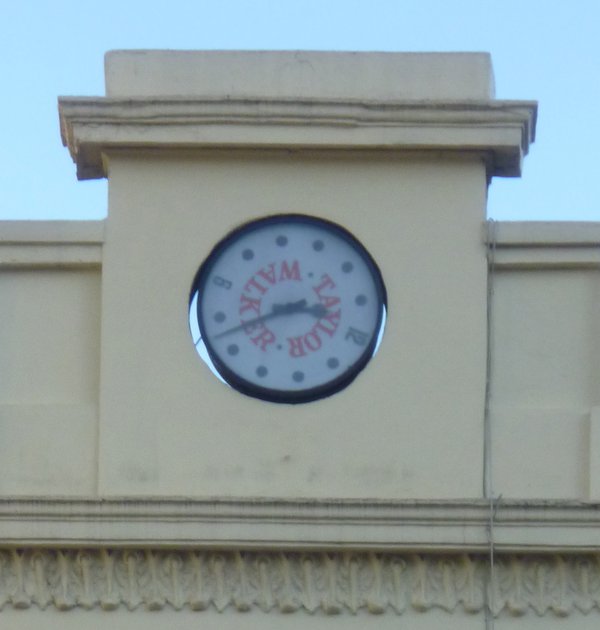

The column that we now see is not Edward Pierce’s original. That was removed in 1773 (in my next blog I will discuss what happened), and for two centuries there was nothing on the roundabout.
In 1984 a charity was set up (the Seven Dials Monument Charity, now Seven Dials Trust), who managed to raise funds to restore what it called 'one of London’s great public ornaments'.
Five years later the new column was unveiled, complete with six new sundial faces in a striking blue colour. There is much explanatory information on and around the pillar. Do have a look when you are next in London’s West End.
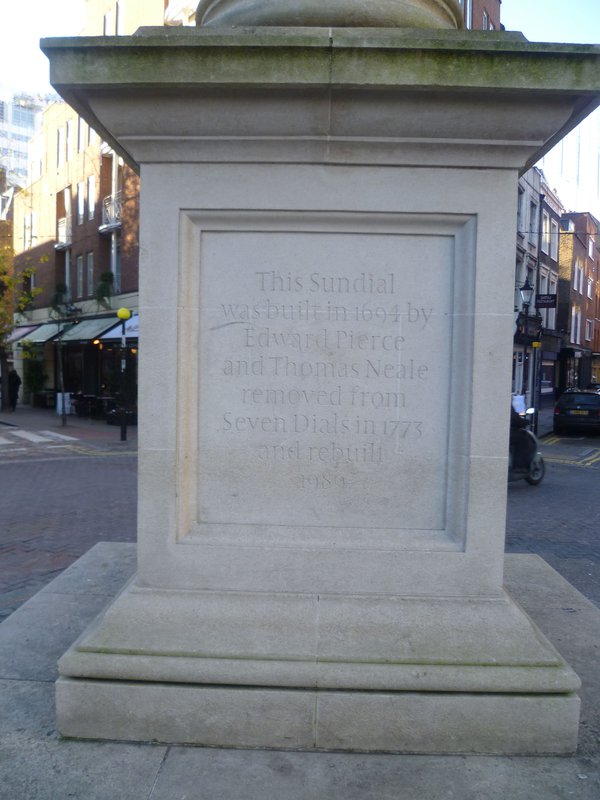


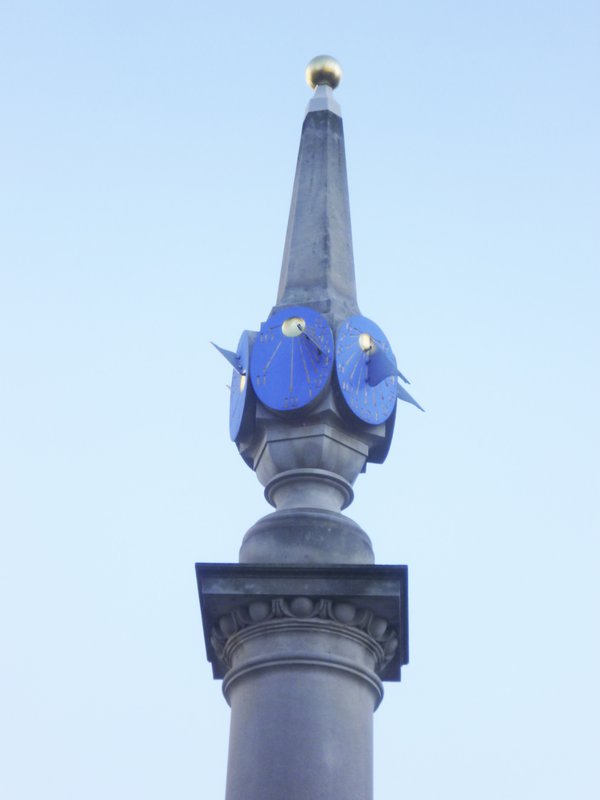
All the nation’s oil paintings online
This post was written by David Rooney
Richard Dunn’s blog post about the Board of Longitude online project reminded me of another exciting digitisation. The ‘Your Paintings' website, run by the BBC in partnership with the Public Catalogue Foundation, aims to show every oil painting held in a UK national collection.
This is a remarkable project. You can see 212,861 paintings online!
I work at the Science Museum, and 297 of our paintings are represented on the site. I picked out three to show you, by Edward Frederick Skinner, depicting file-making and spring-making during the First World War.

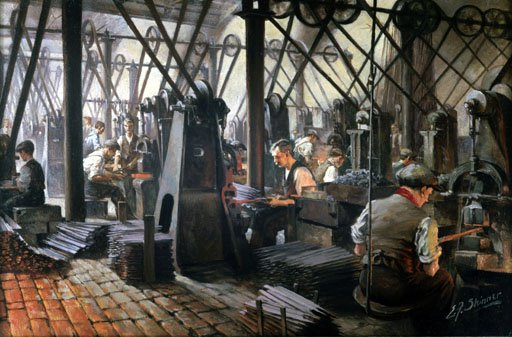

OK, they’re not strictly horological, but I think they’re wonderful, and offer a welcome view of women in the engineering workplace too.
This is also an interactive project. You can get involved by tagging the paintings – choosing your own words to describe what can be seen in the images. This will grow to become an important user-generated finding aid.
And so to horology. There are 59 paintings which include the word ‘clock’ in the title. 157 include the word ‘watch’ (though that one’s clearly not such a good search term). ‘Horology’? None, yet, but for ‘antiquarian’ there are three. And there’s one with the word ‘horological’ (the British Horological Institute’s collection is represented).
But that’s titles. Like I said, you can tag paintings yourselves, so if you find a painting which depicts a watch, or a clock, or a fusee-cutting engine or whatever, then tag it – whatever its title – and help others find it in future.
My fellow blog-writers from the British Museum and the National Maritime Museum will doubtless chip in to mention highlights from their own collections. But, really, it’s hard to know where to start! Happy viewing…
Stand up for watches
This post was written by David Thompson
Today we all take the ownership of a plain ordinary watch for granted and such watches are easily purchased at easily affordable prices. The same is true of the cheap and simple clock, be it a wall clock for the kitchen or a carriage clock for the shelf or mantel.
From the latter part of the 17th century until the end of the 19th century it has been possible to purchase a stand which enabled the owner to transform the watch into either a wall clock or a shelf clock simply by placing the watch in a specially made case.
Examples vary in shape and size, but two relatively rare ones are shown here. The first is a splendid tortoise-shell and ebony-veneered stand which can either be wall mounted or table standing. It is designed with an opening front to enable a common pocket watch to be placed inside to perform as a clock. It was made in England in about 1690-1700, and is enhanced by a portrait bust of King William III surmounted by a crown on the front brass decorative panel.
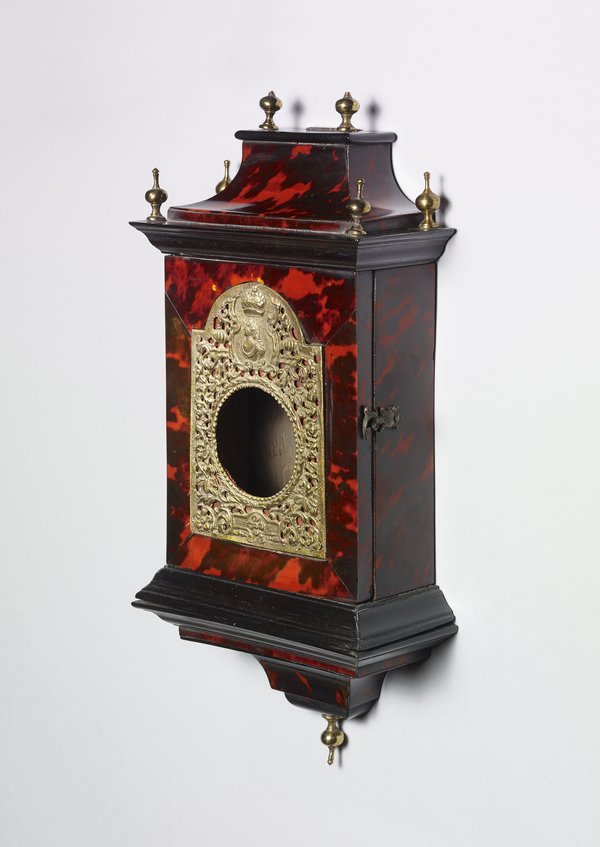

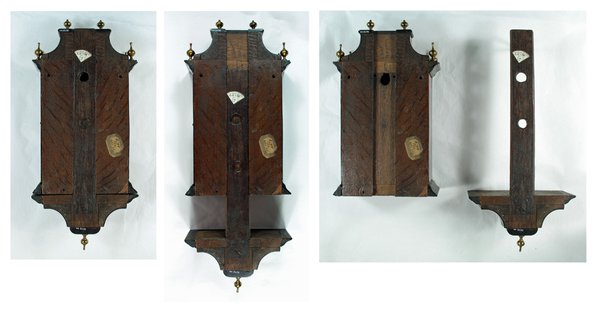
From a similar period is a French example which has a characteristic so-called ‘boulle’ case.
The technique of inlaying brass into tortoise-shell was pioneered in Paris by Charles André Boulle 1642–1732 and in consequence this type of work is named after him, although there were many workshops in Paris using this amazing technique. The material actually used was not tortoise but commonly hawksbill turtle. In some instances the craftsman would make use of the negative and here the pattern on the back is the negative left from producing the brass inlays for the front.


In contrast to these two elaborate and relatively expensive watch stands, lastly is a 19th century stand consisting of a simple folding wooden box which would allow an ordinary watch to be placed on a bedside table for night use.
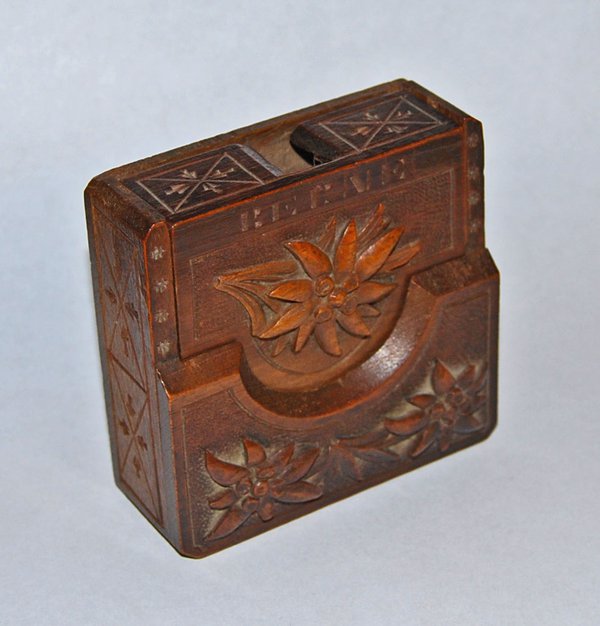

John Harrison and the Board of Longitude go digital
This post was written by Richard Dunn
Last week, the Cambridge Digital Library launched some samples of material from the Board of Longitude archive that will interest anyone wanting to know more about John Harrison, the Board of Longitude and the development of timekeeping at sea (among many other things).
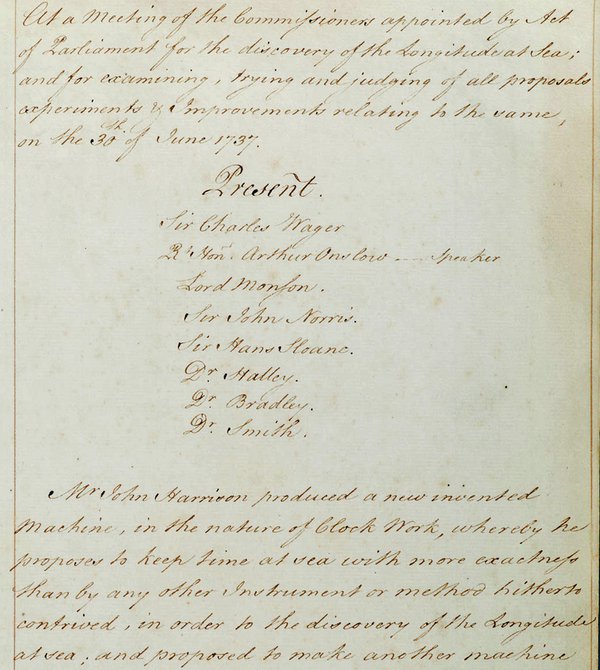
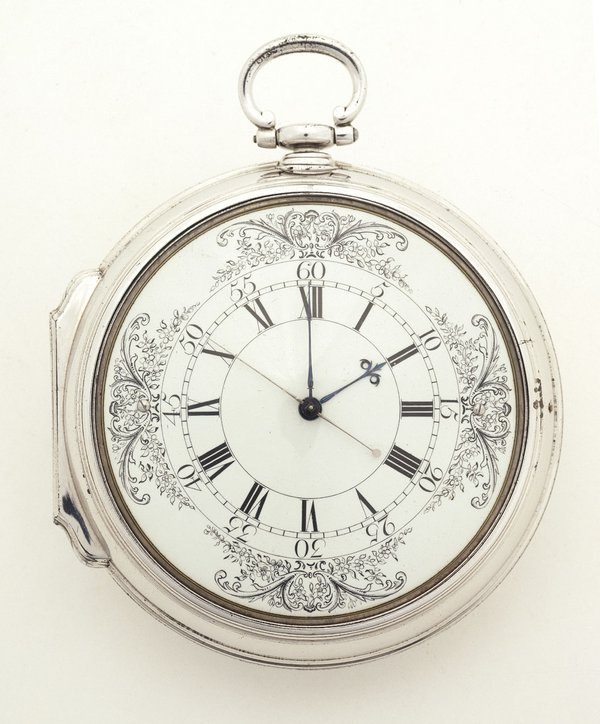
Three volumes from the Board’s archive have just been put up: the first volume of confirmed minutes (1737-1779), which includes a full transcription and covers all the meetings involving John Harrison; William Wales’s log from James Cook’s second voyage (1772-75), on which Larcum Kendall’s first marine timekeeper (K1) was tested alongside three by John Arnold; and a group of letters and reports by astronomers and captains from late-18th and early 19th century voyages of discovery.
For all three volumes, there are also links with the collections at Royal Museums Greenwich.

The trial launch is part of a JISC-supported project, ‘Navigating Eighteenth Century Science and Technology: the Board of Longitude’. This is a collaboration between Royal Museums Greenwich and the University of Cambridge that is going to digitise all the surviving archives of the Board of Longitude and related material in Greenwich and Cambridge. The remaining material will go online during the summer of 2013.
The project team would like to get feedback on how the current version works and things they can do to improve it. There should be lots of interesting stuff in the three volumes now online, so please have a look and leave any comments via the feedback function on the Cambridge Digital Library.
What on earth?
This post was written by James Nye
In a few days, Francoise Collanges will embark on a project involving the Alexander Bain clock at The Clockworks. We will survey the clock, compare it with examples at the Science Museum, the Guildhall and Greenwich, and work out how to operate it safely over the long-term.
Someone asked if we intend to drive it with an earth battery (the way Bain did), and this reminded me of an experiment, back in the 1990s.

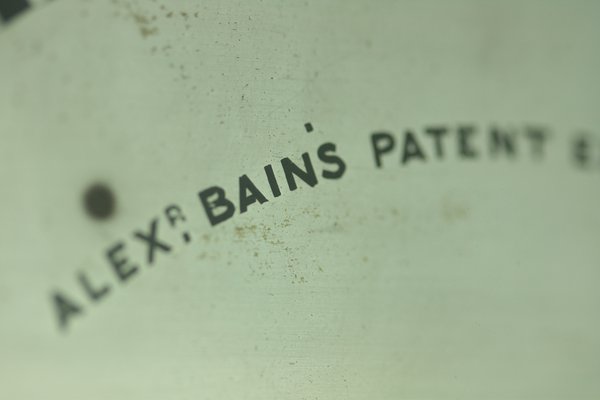
What’s an earth battery, you may ask? Remember the ‘potato clock’, where the power for a small battery clock comes instead from a galvanised nail and copper wire inserted into a potato? The potato provides the ‘electrolyte’ between the two metals – it’s the water in the potato really – allowing electrons to pass from the zinc to the copper, providing Volts.
In an earth battery, the moist soil beneath the surface allows the same thing. The battery is ‘used up’ as the zinc disappears.
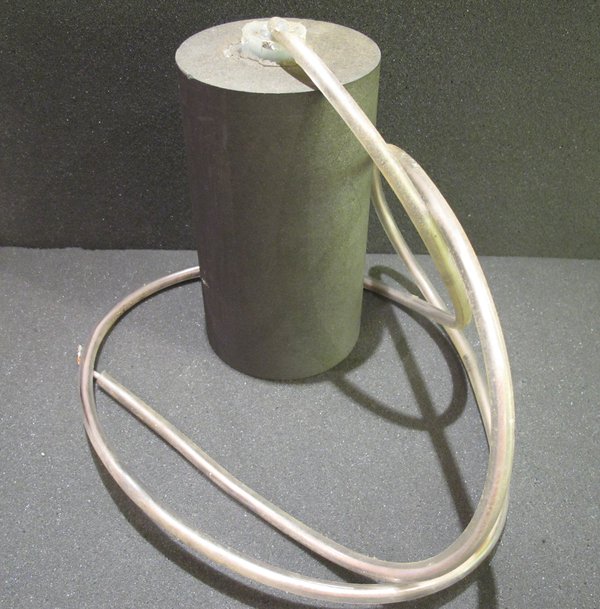
Elements can be ranked ‘galvanically’ – indicating the volts you can achieve from a combination. Magnesium/copper gives 1.45V, zinc/copper (potato clock) 0.9V. But Bain buried zinc plates and a lump of retort coke (carbon), producing 1.1V, enough for his sensitive clock.

In Leicester, an earth battery apparently powered a clock for about fifty years, and we set out to beat this run – calculating the zinc needed, given the rate at which it would be consumed – 2,671 grams in our case. Two specialist firms produced the carbon and zinc electrodes to our design.

I buried them a metre down and ran a clock for several months. But the battery stopped working. A post mortem suggests a flaw in our zinc block – it should probably have been a large thin plate – with maximum surface area. The thousands of surface flaws in Bain’s retort coke were actually an advantage. We could give it another go at The Clockworks – trouble is, we sit on concrete, so we’ll need to ask the neighbours if we can bury electrodes in their garden!
Sundials can be sobering and noisy
This post was written by Peter de Clercq
Whereas a clock or a watch tells us at a glance what time it is, finding the time with a sundial is less easy. And it only works when the sun shines. Serious limitations, one might argue.
But this does not make them less attractive or fascinating. Indeed, there are societies entirely devoted to the subject, such as the British Sundial Society (BSS) whose members study and record old sundials and enjoy designing and discussing new ones.
Sundials come in many sorts. Like clocks and watches, they range from pocket-sized (Figure 1) to monumental (Figure 2), and from straightforward to mind-bendingly complicated.
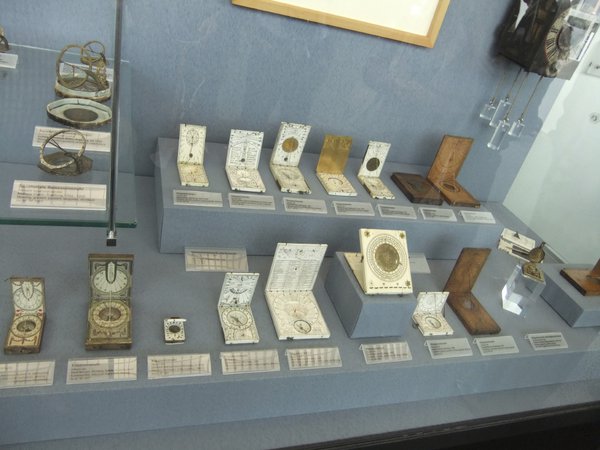
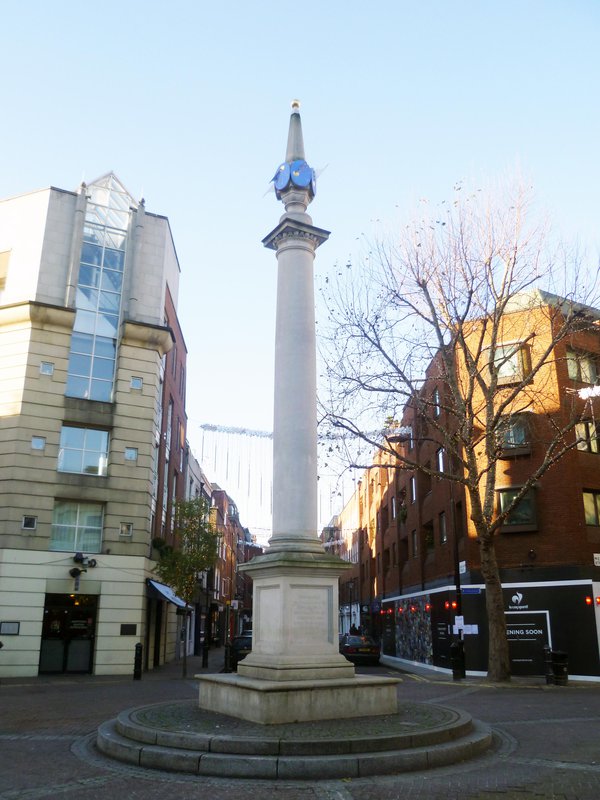
What I like about them is that they can come with arresting imagery and texts. An example is the sobering memento mori we saw years ago on an Austrian church (Fig 3). The Grim Reaper would fit perfectly in the exhibition Death: A Self-Portrait, currently at the Wellcome Gallery in London.
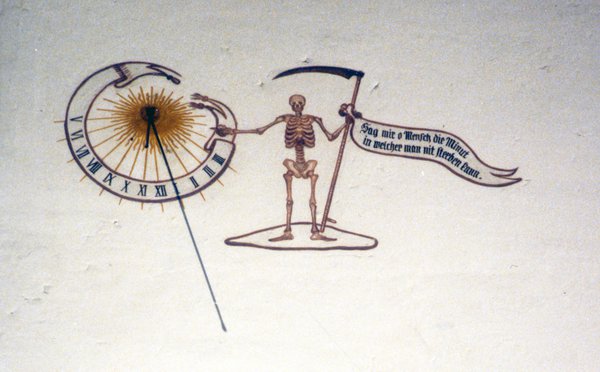
Sundials are quiet. Not for them the reassuring tick-tack of a clock, or the quarterly or hourly chimes.
But there is one exception: the cannon dial, also known as solar cannon or noon cannon (Fig 4). It is fitted with a burning lens, so arranged that the Sun’s rays are directed to the touch hole of a small cannon. At noon precisely, it goes off with a bang! People could set their watches by it (Figs 5 and 6).
It was an acoustic variant of the Greenwich time ball, which for generations has been dropped every day at 1 pm sharp – initially for ships’ navigators to check their chronometers, and now purely as an enjoyable public spectacle.
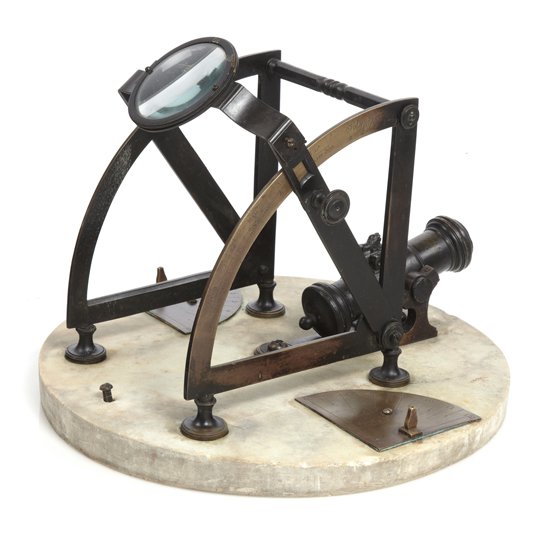
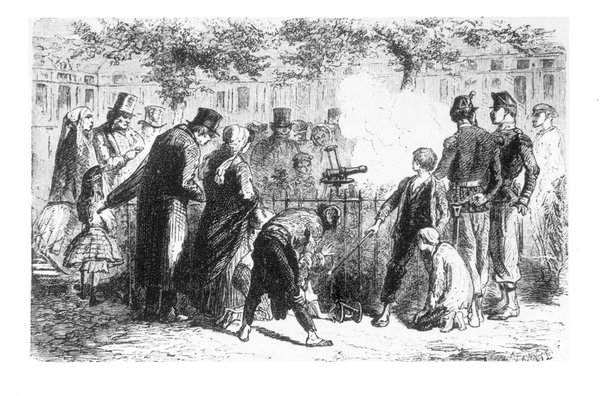
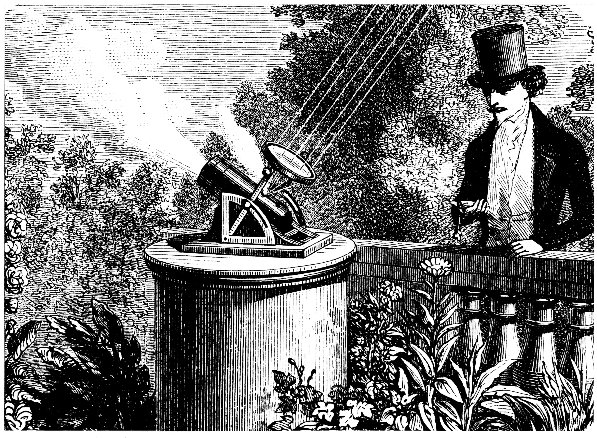
Seventy-Seven Clocks
This post was written by David Rooney
One of the security officers where I work stopped me a few weeks ago. He was reading a crime fiction novel and thought I might be interested. It’s called ‘Seventy-Seven Clocks’. You can perhaps see why he thought of me.
During these long January evenings, many of us find time to catch up on our reading – and there’s a lot to catch up on.
I am sure you are already onto your second reading of Bob Miles’s superb masterwork on the Synchronome company, published by the AHS last year. And if you haven’t yet seen a copy of Ian White’s exploration of English clocks for the Eastern markets, the AHS’s latest book, then there’s a treat in store for you.
But having devoured those two books, you might want something a little lighter, and for that, I can recommend Christopher Fowler’s Seventy-Seven Clocks.

With chapter titles such as ‘Horology’, ‘Clockwork’, ‘Automaton’ and ‘Mechanism’, it’s shot through with mechanical ingenuity. (There’s also ‘Vandalism’, ‘Detonation’, ‘Darkness Descending’ and ‘Glorious Sacrifice’, so it’s not for the faint-hearted.)
I don’t want to spoil the plot, but suffice to say anyone who’s a member of the Worshipful Company of Clockmakers, or who collects clocks and watches, or who has ever been involved in running a business might well be absorbed by Fowler’s fictional tale.
It’s beautifully detailed, acutely observed, and full of horology – although I never imagined it could be so wicked ! I’ve since read other titles in Fowler’s series and they’re great. One mentioned the sundial-fountain in St Pancras Gardens by horological philanthropist Baroness Burdett-Coutts that I wrote about a few months ago. Coincidence!
Happy reading, whatever’s on your bedside table, and very best wishes to you all for 2013.
Time to pay
This post was written by David Thompson
With all the current talk about taxation, I am reminded of a futile attempt to raise money introduced by William Pitt in 1797. Now commonly referred to as the Clock Tax it involved the levy of charges for clocks and watches under an act which was put into effect on the 5th July 1797.
Under the act, levies would be charged at the rate of 5 shillings for every clock and 10 shillings for every gold cased watch or a watch with a case enamelled on gold. Silver and base-metal cased watches would incur a charge of one shilling and six pence. Householders, tenants and businesses alike were to provide a signed declaration of all the clocks and watches in their possession for the purposes of assessing the amount to be paid. Inspections would be made and the taxes levied according to the number of items.
Of course, people hid their clocks and watches and made false depositions to such an extent that the whole idea became unworkable and was quickly abandoned.

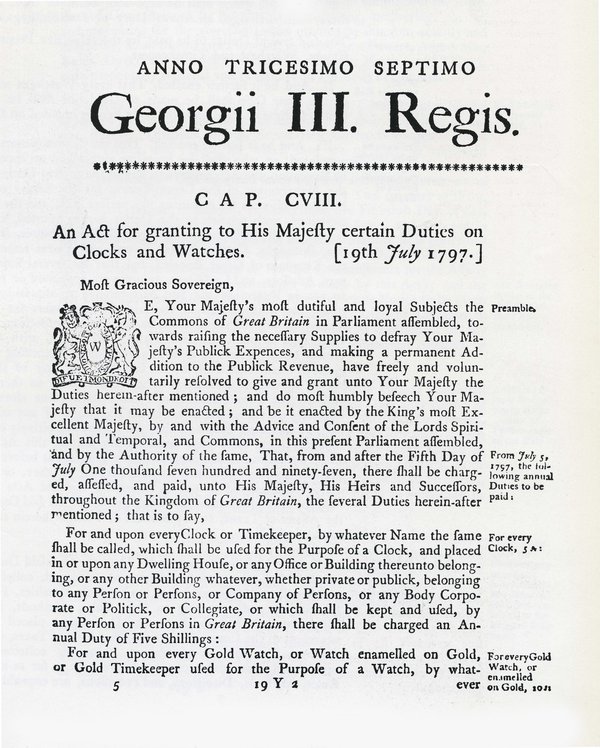
At the time of the tax a rather splendid satirical print was made suggesting that as the tax was something of an absurdity, perhaps the government were considering levying a tax on the embroidered decorations on stockings which are called ‘clocks’. The coloured print was made by A.C. Ansell in the style of the well known caricaturist George ‘Moutarde’ Woodward and published by S.W. Fores of 50 Piccadilly, London, on 9th August 1797.

With the increasing use of mobile phones as time-tellers, perhaps the answer today is a tax on these ubiquitous items!
(Thanks to Marjorie Hutchinson for timely advice)